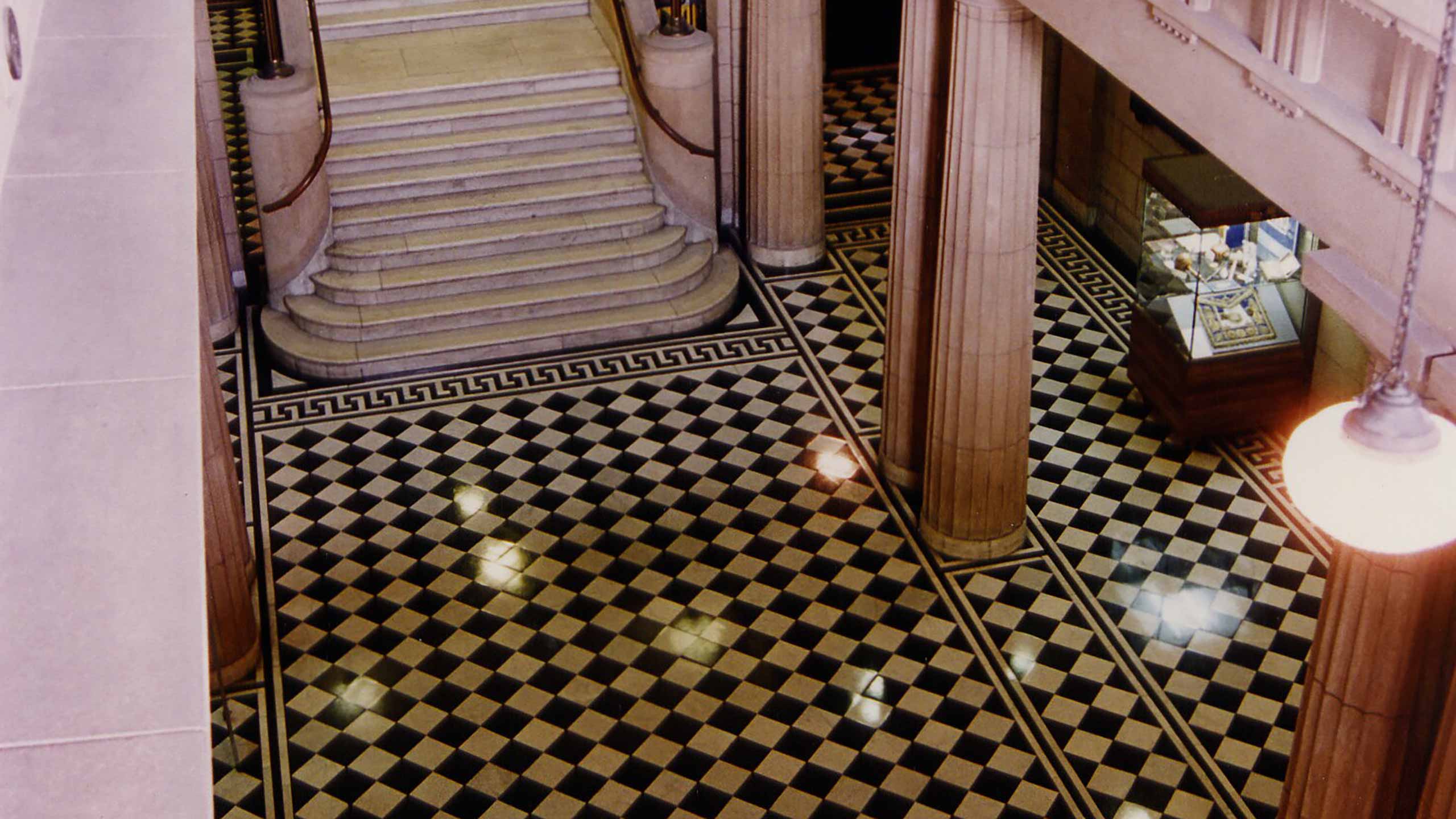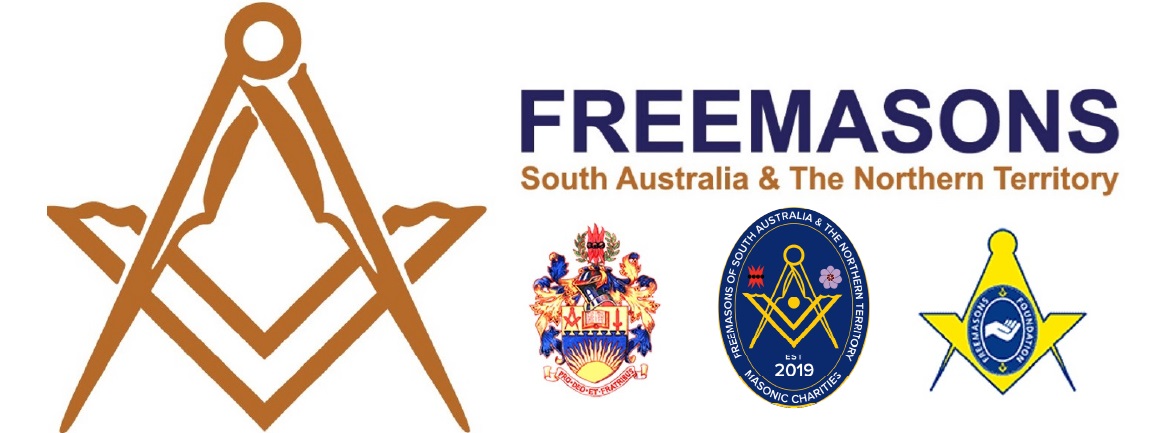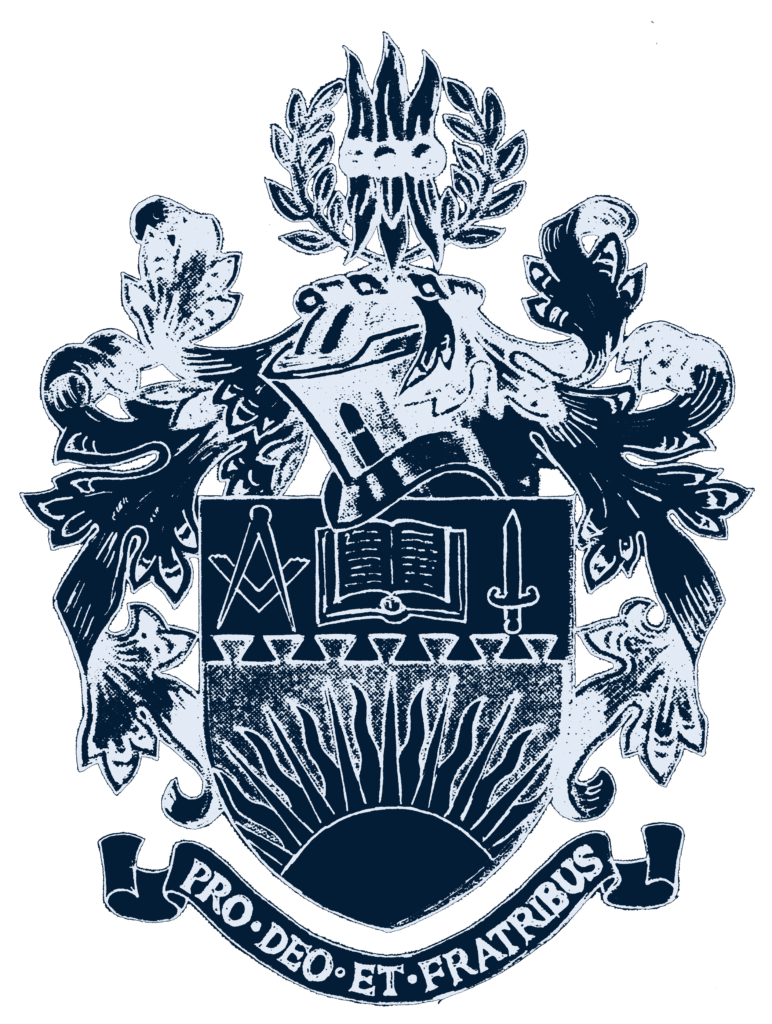A Full History of Freemasonry
In 1984 RW Bro. Jeremy Pemberton, President of the Board of General Purposes of the United Grand Lodge of England, gave an address at the Centenary Conference of the Grand Lodge of South Australia.
It covered so completely the history of Freemasonry that it is reproduced here in full:
There is a much used Masonic expression, “time immemorial”, which has become almost meaningless, but has some convenience, enabling us quickly to gloss over many gaps in our history. As a lawyer I cannot resist recalling that in English law time immemorial means time before 1189 – the beginning of the reign of King Richard I. In Masonry it was customary to state that the Craft had existed from time immemorial, meaning that we do not know when it originated, and the use of that expression “time immemorial”, has enabled many Masonic writers to give full rein to their imagination when writing on our origins. Dr. James Anderson, when compiling the first official Constitutions of 1723, prefaced the Regulations with a purported history of Masonry tracing it back to Adam in the Garden of Eden, and going on from there to include many biblical, historical and some purely legendary personalities as protector, promoters or Grand Masters of the Art.
Many later writers followed Anderson’s example and, without providing factual evidence, attempted to prove that Freemasonry descended from the Ancient Mysteries of classical times, the Egyptian pyramid builders, King Solomon himself, the Roman Collegia, the Comacine Masters, the German Steinmetzen, the French Compagnionage, the Mediaeval Knights Templar or the Rosicrucians. The most durable and probable theory is that we are descended directly or indirectly from the mediaeval operative stone masons who built the great cathedrals and castles. While much evidence exists which apparently demonstrate a link between operative and speculative Masonry, yet like Darwin’s theory of evolution, there are missing links which need to be found before theory becomes proven lineal descent.
Those who advocate the theory of a direct link between operative and speculative Masonry base their claims on a combination of evidence from England and Scotland. In England the operative mason’s lodge was simply a wooden hut in which he took his refreshment and kept his tools. In Scotland the Mason’s Lodge was a geographically defined unit controlling the wages and working conditions of the stone masons. These Scottish lodges had a brief initiation ceremony for apprentices, and had a secret word, which enabled their members to gain work and sustenance when they travelled from one site to another. In the 17th century these Scottish lodges began to admit local gentry as “non-operative” members or “gentleman masons”, and the claim is that these non-operatives gradually began to gain ascendancy over the operatives in the transition period, until they dominated the lodges and turned them into lodges of purely speculative Freemasons. Unfortunately for the supporters of this theory, there is no firm evidence of a similar development in England; indeed in England there is no evidence of the existence of operative lodges or of a Mason word. In the 17th Century the first evidence we have of a purely speculative initiation in England is that of Elias Ashmole at an occasional lodge held in Warrington in 1646, none of those present having anything to do with the operative craft. From that event until the formation of the premier Grand Lodge in 1717 all the evidence in England occurs in a purely speculative context.
Those on the other hand, who support an indirect link with operative Masonry, claim that it arose as a result of the religious and political divisions of the 16th and 17th Centuries. They suppose that the founders of speculative masonry were men of goodwill, but of differing opinions, who wished to join together to promote a way of life based upon the principles of brotherly love, relief and truth, without the intrusion of divisive argument over religious or political dogma. In the tradition of their time they promoted their philosophy by means of allegory and symbolism, and as their central idea was the building of a better world, in which mankind could be better prepared for life eternal they took as their allegory the building of King Solomon’s Temple, the only building described in detail in the Bible; and adopted the forms and working implements of operative stone masons on which to build their increasingly elaborate symbolism. If, then, our origins remain shrouded in mystery what are the facts?
On the 24th June 1717, four London lodges, which possibly had been in existence for thirty years, came together to form a Grand Lodge, the first in the world. At their meeting they elected Anthony Sayer, one of the Senior Masters present, to be the first Grand Master and resolved to meet together annually. Initially this was all that was done. The Annual Assembly was simply a Festival, and not in any sense a regulatory body. Within a few years, however, the Lodges had increasingly begun to attract men of intellectual ability, who transformed the Annual Feast into what we would now recognise as a Grand Lodge. By 1730 the original four London Lodges had increased to 76 spread over England and Wales and the Grand Lodge was meeting quarterly as a regulatory body. It issued an official Book of Constitutions, set up a Central Charity Fund, appointed provincial Grand Masters to act for the Grand Master in the more distant parts of the country, and began to export the Craft abroad by granting deputations, which we would now call Warrants, to constitute lodges in Gibraltar and India. The Craft in general at this period was a very convivial society.
Lodge meetings usually took place in a private room in a tavern. The ceremonies were fairly short and simple and much of the evening was spent round a long trestle table at which the normal business of the lodge was transacted, and the ceremonies were explained and expounded by means of lectures in the form of questions and answers. Refreshments and tobacco were available throughout the meeting, which was often rounded off by the singing of part-songs and glees.
With regular newspaper reports of meetings, public processions in regalia, and the staging of special theatrical performances, at which the brethren wore their regalia, the Craft attracted public attention. To cash in on public curiosity, purported exposures of the ritual began to appear, followed by satires and cartoons. One result of the actions taken by the premier Grand Lodge to counter this adverse publicity was the formation in 1751, of a rival Grand Lodge in London, now known as the Antients Grand Lodge from their claim to be the only practitioners of Freemasonry “according to the Antient Institutions”. Despite serious rivalry, and the fact that neither regarded the other as regular, the two Grand Lodges existed side by side, both at home and abroad, for some sixty years until under the Grand Mastership of the two Royal Brothers, the Duke of Sussex as Grand Master of the premier Grand Lodge and the Duke of Kent as Grand Master of the Antients Grand Lodge, the two were brought together to form the United Grand Lodge of England on 27th December, 1813 with the Duke of Sussex as Grand Master. The Union brought about many changes in English Freemasonry, not least in the manner in which meetings were conducted. The Duke was a great universalist, and while the Craft had always been open to men of all faiths, there was much in the 18th century ritual and lectures that was overtly Christian. A Lodge of Reconcilation was set up immediately after the Union to determine the ritual to be followed by all Lodges. In fact, this special lodge completely reorganised the ritual, removing nearly all the Christian symbolism, greatly extending the simple ceremonies of the 18th century to those we practice today, including material from the catechetical lectures, and bringing about a complete break between the actual meeting and the convivial after-proceedings.
The formation of the premier Grand Lodge in 1717 was followed by that of Ireland in 1725 and that of Scotland in 1736. In no sense rivals, the three Grand Lodges developed on individual lines, having a tacit understanding that, whilst overseas territories were open to all three they would not warrant Lodges within each other’s territories. The history of the spread of British Freemasonry closely parallels the development of the British Empire; wherever settlers or British Regiments went, Freemasonry soon followed. The spreading abroad of British Freemasonry was greatly facilitated by the granting, particularly by the Antients Grand Lodge and the Grand Lodge of Ireland, of so-called ambulatory warrants to Lodges in the Army. These Warrants permitted the Lodge to be held wherever the Regiment was stationed, and although the intention was originally that Lodge membership was to be limited to members of the Regiment, if they were stationed in one town for any length of time they soon began to take in local civilians. When the Regiment moved on, the local Brethren then applied to one of the home Grand Lodges for a warrant to hold a Lodge within the town.
As a result, the two Grand Lodges of England appointed some twenty-two provincial Grand Masters for various parts of America between 1730 and 1783, made similar appointments for parts of India from 1729 and Canada from 1750, and even warranted a Lodge to meet in Canton in China in 1767. The Irish and Scottish Grand Lodges were no less active, and by the close of the 18th century, British Freemasonry had been introduced into the Americas, Canada, the West Indies, South America, India and certain African ports. The American Lodges gradually declared their independence during the war which created the United States, forming State grand Lodges which in turn spread Freemasonry across the nation as it expanded westwards.
Nor was Europe neglected. The premier Grand Lodge introduced English Freemasonry into France, Spain, Italy, Switzerland, the German States, Holland, Scandinavia and Russia. Europe was to be a fertile ground for the development not only of the Craft but of many additional degrees. It was, unfortunately, also to be a fertile ground for the perversion of genuine Freemasonry for political ends, and many pseudo-Masonic organisations grew up which were in fact political clubs. It was for this reason, as well as on account of the taking of oaths and our Masonic secrets, that the Vatican issued the first Papal Bull against Freemasonry in 1738, a Bull which was to be reinforced on a number of occasions in the following hundred and fifty years. These continental pseudo-Masonic political and anti-clerical societies also inspired the great conspiracy theory of Freemasonry; the theory of its being an international organisation working for world domination in a political sense; and this led to the many attacks on the integrity of Freemasonry in the 19th and 20th centuries, many of them deliberately fabricated by their authors to achieve political ends.
The 19th century saw the opening up of Africa, Asia, the Far East and of course, Australia and New Zealand, and the 18th century pattern of the Craft following the colonists and the Army was repeated. But just as the older parts of the Empire were beginning to strive for political freedom from the Mother country, so the older colonial Lodges began to look towards separation. The 1850’s was not a happy period for the United Grand Lodge of England. A major crisis arose in 1855 when the Lodges in what is now the Province of Ontario, Canada, complained of neglect by the Grand Lodge, letters going unanswered, petitions and fees going unacknowledged. Matters were patched up for a little while but soon slipped back, causing the Lodges in Ontario to set up their own Grand Lodge. When it became clear that independence was the only solution, the Ontario Lodges were granted their freedom and the Grand Lodge of Canada in the Province of Ontario was formed. Valuable lessons were learnt from this experience, and the system was developed by the home Grand Lodges of holding a plebiscite of the lodges in a particular area when they wished to form their own Grand Lodge. Provided that a majority was in favour, that the new Grand Lodge would be the sovereign Masonic Craft governing body in the whole state or country, and that any English, Irish or Scottish lodge within the territory which wished to remain under its parent Grand Lodge was permitted to continue working without interference from the new Grand Lodge, the home Grand Lodges gave their blessing to the formation of the new Grand Lodge and granted formal recognition once it was established.
The Craft was introduced into Australia in 1803 when a number of Ship’s Officers and residents of Sydney held a meeting, but not having the approval of the Governor, the prime mover, H. Brown Hayes was exiled to the new British Settlement in Van Diemen’s Land. It was not until 1816 and the arrival of the 46th Regiment with its travelling Lodge of Social and Military Virtues, No.227 under the Grand Lodge of Ireland, that Freemasonry took lasting root. This resulted in the first Australian Lodge, the Australian Social Lodge No.260 of the Irish Constitution being formed in New South Wales in 1820.
The Craft was introduced into South Australia by the United Grand Lodge of England and in a most unusual way. A number of Brethren who were planning to come out to Adelaide in 1834 petitioned for the grant of a Warrant. This was readily agreed to, and the Grand Master issued Warrant No.613 on 22nd October 1834, sanctioning the formation of the South Australian Lodge of Friendship. Hardly was the ink of the Grand Master’s signature dry when the Warrant was taken that same day from Freemasons’ Hall in London for a distance of less than a mile to No.7 John street, Adelphi, off the Strand, where the Lodge was formally constituted, and met on a number of occasions. It was to be almost four years before the Lodge reached South Australia. On 11th August 1838, it first met at Black’s Hotel, Franklin street, Adelaide. Now, of course, it is the Lodge of Friendship, No.1 on the Register of the Grand Lodge of South Australia and I had the great pleasure of attending a meeting of this your oldest Lodge yesterday evening. The formation of the Lodge of Friendship was to be followed by the granting of more warrants for Lodges in South Australia, and the appointment of Henry Mildred as provincial Grand Master, under the English Constitution, on 22nd November, 1847. Ireland and Scotland followed suit and the three constitutions worked together in amity. When the desire for self-determination grew, the Brethren who formed the Executive Committee for the Masonic Union in South Australia, showed great tact and foresight in not rushing matters, and in making sure that they had the full support of the Lodges. As a result, when the event whose Centenary we are now celebrating, the formation of the Grand Lodge of South Australia, took place on 17th April, 1884, the new Grand Lodge was quickly recognised by the United Grand Lodge of England followed by those of Scotland and Ireland. The final seal of approval came in 1888 when The Prince of Wales (later King Edward VII) who was then Grand Master of the United Grand Lodge of England, and Grand Patron of the Grand Lodges of Ireland and Scotland, accepted the title of Patron of the Grand Lodge of South Australia.
Such, my friends, is a very brief account of the origin and development of the Masonic Craft, and of the events leading to the establishment of the Grand Lodge of South Australia on 17th April, 1884.
More about Freemasonry

Venue hire
Freemasons Hall is the ideal venue for a number of different functions. From the iconic marbled foyer and elegant staircase, the large and impressive Great Hall at Ground Level to the Sam Jacobs room.

Community Benevolence
Charity is found at the heart of Freemasonry, with members actively involved in helping those in need since the craft started.

Research and study
The Masonic Learning Committee (MLC) seeks to develop a sustainable 'bottom up' Masonic Learning framework aimed at providing individualised, specialised programs of learning.

